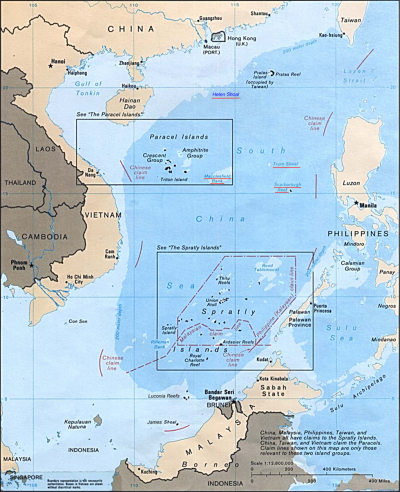By Eric Sommer
The Obama administration would do well to apply lessons from the Korean War 55 years ago if it wants to avert a new war with China, which is growing increasingly wary of the US military’s presence in the region.
Tensions between the US and China have been severely exacerbated in recent days by repeated flights by US military aircraft near the Chinese-controlled artificial islets being built with land from the sea bottom in the South China Sea’s Spratly Islands.
The US military – under the pretext of defending ‘freedom of navigation’ in the sea – plans to conduct flyovers above the territorial 12-mile limits around the islets. This is reckless almost beyond words and may easily escalate into a military conflict between the two nuclear-armed powers. The Chinese government has lodged an official protest against flights near the islands, and the Chinese government newspaper, the Global Times, stated in an editorial: “If the United States’ bottom line is that China has to halt its activities, then a US-China war is inevitable in the South China Sea.”
The real explanation for the US military intrusions around the islets is quite different. It is part of a long-term campaign to encircle and isolate China for the purpose of intimidating, weakening, and possibly even destabilizing China to the point where the independent government is replaced by a client state of the US. This campaign is officially referred to as the US ‘Pivot to Asia’ and is made up of military, economic, and informational elements aimed at isolating and weakening China.
The military element of the encirclement campaign is officially called the ‘Air-Sea Battle-Plan’, which involves the transfer of up to 60 percent of US military forces – equipped with the latest military equipment – into the Asian theater. The plan also involves creating new US military agreements and new US military bases for American forces in countries around China, including Australia, the Philippines, South Korea and Japan.
 The economic element of the encirclement campaign is the Trans-Pacific Partnership (TPP.) The TPP is a US-proposed treaty – currently the subject of negotiations between Australia, Brunei, Canada, Chile, Japan, Malaysia, Mexico, New Zealand, Peru, Singapore, the United States and Vietnam – intended to impose regulatory and investment conditions in Asia. More importantly, it would exclude China from the new economic zone.
The economic element of the encirclement campaign is the Trans-Pacific Partnership (TPP.) The TPP is a US-proposed treaty – currently the subject of negotiations between Australia, Brunei, Canada, Chile, Japan, Malaysia, Mexico, New Zealand, Peru, Singapore, the United States and Vietnam – intended to impose regulatory and investment conditions in Asia. More importantly, it would exclude China from the new economic zone.The informational element of the encirclement campaign consists of accusations by US political figures, which are endlessly repeated in the US mass media, claiming there is a ‘China threat.’ This assertion stands reality on its head. After all, the US has approximately 650 military bases around the world and is waging continual wars; China has no military bases in foreign countries and has waged no wars in the last 30 years.

These military, economic, and informational attempts to encircle China reflect US foreign policy concepts are known as ‘the Brezinski Doctrine’ and “the Wolfowitz Doctrine,’ which basically state that for the US government to remain the dominant power on Earth it must secure total dominance of the Eurasian continent, upon which the independent nations of Russia and China occupy central positions.
Following these doctrines, while continuing to attempt to encircle China, and ignoring China’s current warnings regarding US military activity around or over its’ islets, is dangerous to say the least. It seems we’ve been here before. Sixty-five years ago, during the Korean War, China similarly warned that US-led military forces must not occupy its neighbor, North Korea, nor bring its military forces near the North Korea-Chinese border. Despite some alternate views, the consensus among most US policy makers at that time was that China’s’ warnings were a mere bluff, and that it would not intervene in the Korean War as the US-led forces moved to occupy North Korea. In fact, China’s warnings were an attempt to avoid a military confrontation with the US military.
When the warnings were ignored, and US-led forces occupied most of North Korea and approached the Chinese border, Chinese military forces massively intervened, driving the US-led forces completely out of North Korea and back into South Korea, where they remain to this day. The result of the US miscalculation was the deaths of large numbers of Chinese, US, and Korean soldiers and civilians as the American forces were driven out of North Korea.
Like its warnings during the Korean War, China’s warnings that some sort of conflict may result from US military intrusions on or near its islet territory should be taken very seriously. Imagine that the US government was building small artificial islets in the ocean off the coast of California, and that China began moving military aircraft and military vessels into the areas around these islets, while insisting that the US had no right to build these islets.
In that scenario, as well as in the current one, there would be a real danger that by miscalculation, accident, or intention by one side or the other a military conflict leading to war with devastating consequences might be triggered.
Hopefully, US policy makers will take China’s warnings seriously, draw back from the encirclement campaign against the country and learn from the disastrous lesson of the Korean War. In that way, we could avoid repeating history while sparing the world yet another terrible war.
 Geostrategic Media Political Commentary, Analysis, Security, Defense
Geostrategic Media Political Commentary, Analysis, Security, Defense





